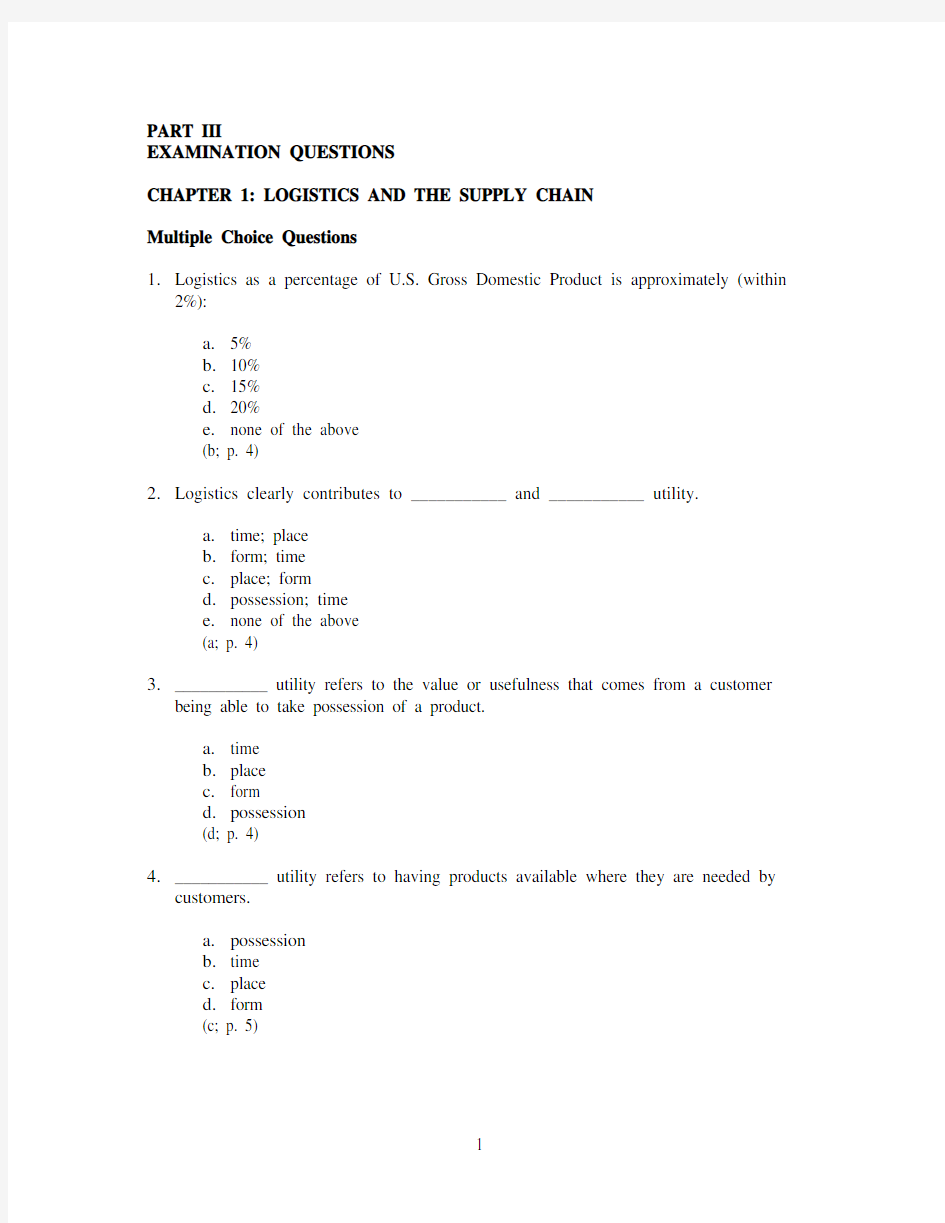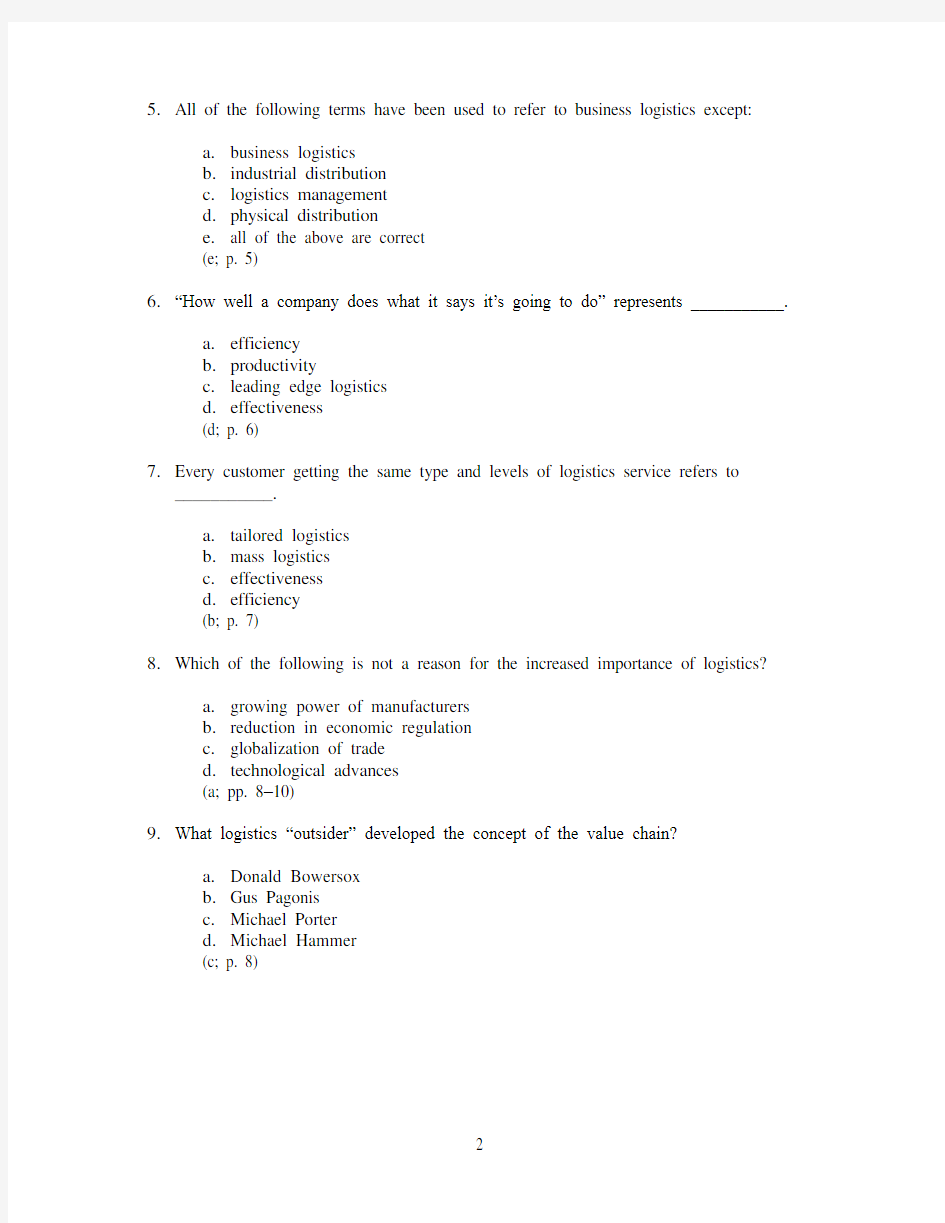

PART III
EXAMINATION QUESTIONS
CHAPTER 1: LOGISTICS AND THE SUPPLY CHAIN
Multiple Choice Questions
1.Logistics as a percentage of U.S. Gross Domestic Product is approximately (within
2%):
a.5%
b.10%
c.15%
d.20%
e.none of the above
(b; p. 4)
2.Logistics clearly contributes to ___________ and ___________ utility.
a.time; place
b.form; time
c.place; form
d.possession; time
e.none of the above
(a; p. 4)
3.___________ utility refers to the value or usefulness that comes from a customer
being able to take possession of a product.
a.time
b.place
c.form
d.possession
(d; p. 4)
4.___________ utility refers to having products available where they are needed by
customers.
a.possession
b.time
c.place
d.form
(c; p. 5)
5.All of the following terms have been used to refer to business logistics except:
a.business logistics
b.industrial distribution
c.logistics management
d.physical distribution
e.all of the above are correct
(e; p. 5)
6.“How well a company does what it says it’s going to do” represents ___________.
a.efficiency
b.productivity
c.leading edge logistics
d.effectiveness
(d; p. 6)
7.Every customer getting the same type and levels of logistics service refers to
___________.
a.tailored logistics
b.mass logistics
c.effectiveness
d.efficiency
(b; p. 7)
8.Which of the following is not a reason for the increased importance of logistics?
a.growing power of manufacturers
b.reduction in economic regulation
c.globalization of trade
d.technological advances
(a; pp. 8–10)
9.What logistics “outsider” developed the concept of the value chain?
a.Donald Bowersox
b.Gus Pagonis
c.Michael Porter
d.Michael Hammer
(c; p. 8)
10.The ___________ approach indicates that a company’s objectives can be realized by
recognizing the mutual interdependence of major functional areas.
a.supply chain
b.systems
c.interfunctionality
d.total cost
(b; p. 10)
11.The movement and storage of materials into a firm refers to:
a.physical distribution
b.materials management
c.materials handling
d.inbound logistics
(d; p. 10)
12.The movement and storage of materials within a firm refers to:
a.physical distribution
b.inbound logistics
c.materials management
d.procurement
(c; p. 10)
13.Logistics managers use the ___________ approach to coordinate inbound logistics,
materials management, and physical distribution in a cost efficient manner.
a.total cost
b.supply chain
c.mass logistics
d.interfunctional
(a; p. 11)
14.A cost trade-off is a situation where:
a.all costs react according to their individual degrees of inflation in the economy
b.all costs are reflected as a percentage variation from standard costs
c.some costs increase, some decrease, and the net effect is that total costs
decrease
d.some costs are eliminated by efficient management controls
(c; p. 13)
15.The cash flow associated with holding inventory is known as inventory ___________.
a.turnover
b.valuation
c.stock
d.float
(d; p. 14)
16.__________ refers to one location where customers can purchase products from two
or more brand-name retailers.
a.intensive distribution
b.co-branding
c.co-generation
d.selective distribution
(b; p. 14)
17.Phantom freight refers to:
a.paying more for transportation than the actual cost
https://www.doczj.com/doc/9517028070.html,te shipments
c.shipments accepted by non-certified carriers
d.freight that “disappears” in transit
(a; pp. 15–16)
18.Freight absorption refers to:
a. a special rate to cover increasing fuel costs
b.rates that are higher than other carriers charge
c.the ability of cardboard to absorb moisture
d.transportation payments lower than the actual costs incurred to ship the
product
(d; p. 16)
https://www.doczj.com/doc/9517028070.html,nded costs refer to:
a. a product that is shipped via surface transport
b. a product that is quoted cost on delivery (COD)
c. a prepaid shipment
d. a price that includes both the cost of the product plus transportation to the
buyer
(d; p. 15)
20.___________ is the excess freight bill paid by customers who live near the shipping
point.
a.freight absorption
b.delivered price
c.phantom freight
https://www.doczj.com/doc/9517028070.html,nded price
(c; p. 15)
21.In FOB origin pricing, all of the following are true except:
a.prices quoted do not include transportation to the consignee
b.marketers can adopt uniform prices on a regional or national basis
c.consignees must arrange for the transportation of the purchased product
d.the seller always receives the same net from each sale
(b; p. 15)
22.___________ refers to a situation where the applicable charges are paid at the time a
shipment is tendered to a carrier.
a.freight prepaid
b.freight absorption
c.phantom freight
d.FOB origin
(a; p. 16)
23.___________ refers to charges being paid at the time of shipment delivery.
a.freight absorption
b.freight yield
c.freight collect
d.FOB destination
(c; p. 16)
24.The four basic components of the marketing mix include all of the following except:
a.price
b.production
c.product
d.place
(b; p. 14)
25.The most common interface between production and logistics generally involves:
a.the use of plastic versus wood pallets
b.the mode of transportation
c.shipment pricing
d.the length of production runs
(d; p. 18)
26.___________ refers to the delay of value-added activities such as assembly,
production, and packaging to the latest possible time.
a.building blocks
b.deferral
c.demurrage
d.postponement
(d; p. 19)
27.The ownership channel consists of all parties except:
a.customers
b.manufacturers
c.wholesalers
d.retailers
(a; p. 19)
28.The ____________ channel handles the physical flow of product.
a.ownership
b.negotiations
c.logistics
d.promotions
(c; p. 19)
29.Which channel covers the movement of title to the goods?
a.promotions
b.logistics
c.finance
d.ownership
(d; p. 21)
30.Which of the following is not part of the marketing channel?
a.the logistics channel
b.the negotiations channel
c.the promotion channel
d.the finance channel
e.all are part of the marketing channel
(e; p. 19)
31.Channel intermediaries:
a.assume temporary ownership of the goods
b.fill niches
c.disappear as the market becomes organized
d.tend to lack focus
(b; p. 24)
32.Intermediaries in the marketing channel perform all of the following functions except:
a.supply information
b.match buyers and sellers
c.assume temporary ownership of the goods
d.develop and fill niches
(c; pp. 23–24)
33.The most costly logistics activity in many firms is ____________.
a.industrial packaging
b.warehousing management
c.order management
d.transportation management
(d; p. 27)
34.____________ is bringing together similar stocks from different sources.
a.accumulating
b.assorting
c.auditing
d.allocating
(a; p. 23)
35.____________ refers to breaking a homogenous supply into smaller lots.
a.sorting out
b.allocating
c.accumulating
d.assorting
(b; p. 23)
True-False Questions
1.Absolute and relative logistics costs in relation to Gross Domestic Product vary from
country to country. (True; p. 4)
2.Logistics clearly contributes to time and form utility. (False; p. 4)
3.The current definition of logistics, as promulgated by the Council of Logistics
Management, suggests that logistics is part of the supply chain process. (True; p. 6)
4.The purpose of logistics is to maximize customer service. (False; p. 7)
5.Logistical principles apply only to for-profit organizations. (False; p. 7)
6.Two of the five primary activities in the value chain are inbound logistics and
outbound logistics. (True; pp. 8–9)
7.The key aspect of the total cost approach is to maximize customer satisfaction. (False;
p. 13)
8.The Internet has done little to improve logistical effectiveness and efficiency. (False;
p. 9)
9.Stock-keeping units (SKUs) are the same as line items of inventory. (True; p.10)
10.Inbound logistics refers to the movement and storage of materials into a firm. (True; p.
10)
11.Inbound logistics is synonymous with materials management. (False; p. 10)
12.Interfunctional logistics attempts to coordinate inbound logistics, materials manage-
ment, and physical distribution in a cost efficient manner that supports an
organization’s customer service objectives. (False; p. 10)
https://www.doczj.com/doc/9517028070.html,mon sense is one of the keys to being an effective logistics manager. (True; p.
11)
14.The key to the total cost approach is that all relevant cost items are considered
simultaneously when making a decision. (True; p. 13)
15.Logistics offers many companies an important route for creating marketing
superiority. (True; p.14)
16.Co-branding is a retailing strategy that is associated with place decisions. (True; p. 14)
17.As a general rule, marketers prefer FOB origin pricing rather than FOB destination
pricing. (False; pp. 15–16)
18.Phantom freight and freight absorption are associated with FOB origin pricing. (False;
pp. 15–16)
19.It is better for a logistics manager to be a generalist rather than a specialist. (False; p.
27)
20.Stockouts refer to a situation where a company is out of an item at the same time that
there is demand for that item. (True; p. 18)
21.Long production runs sometimes result in excessive inventory of products with
limited demand for them. (True; p. 18)
22.Intermediaries assume ownership of goods while the y’re in the marketing channel.
(False; p. 24)
23.Channel members are usually more concerned about sellers’ needs than with buyers’
needs. (False; p. 20)
24.The negotiations channel is the one where buy and sell agreements are reached. (True;
p. 21)
25.There is no linkage between the promotions and logistics channel. (False; pp. 22–23)
26.The most significant contribution that the logistics channel makes to the overall
channel process is the sorting function. (True; p. 23)
27.The sorting function has four steps. (True; p. 23)
28.The sorting function takes place between retailers and the consumer. (False; p. 23)
29.A broker is a type of intermediary often associated with the negotiations channel.
(True; p 24.)
30.In channel negotiations, all parties are presumed to have equal bargaining strength.
(False; pp. 20-21)
31.Freight forwarders are the most common intermediary in the logistics channel. (True;
p. 24)
32.Returned products represent one type of activity in the logistical channel. (True; p. 27)
33.The key to total cost analysis is to make sure that either transportation or inventory
costs are minimized. (False; p. 13)
34.There are relatively few opportunities for employment in the logistics sector. (False; p.
27)
35.The logistics channel is the most important of the marketing channels. (False; p. 19)